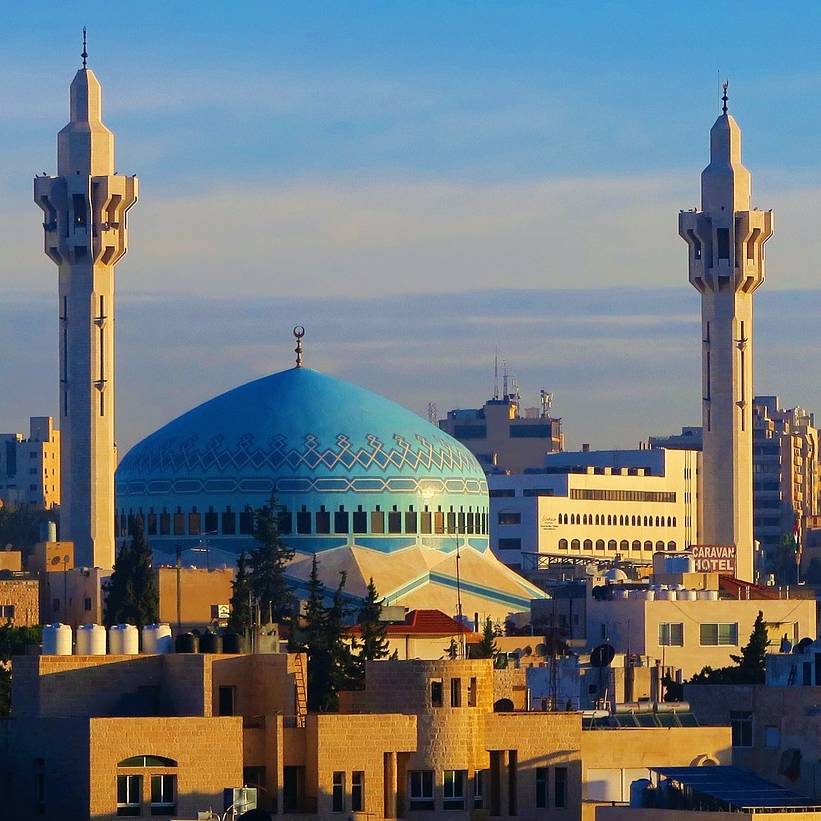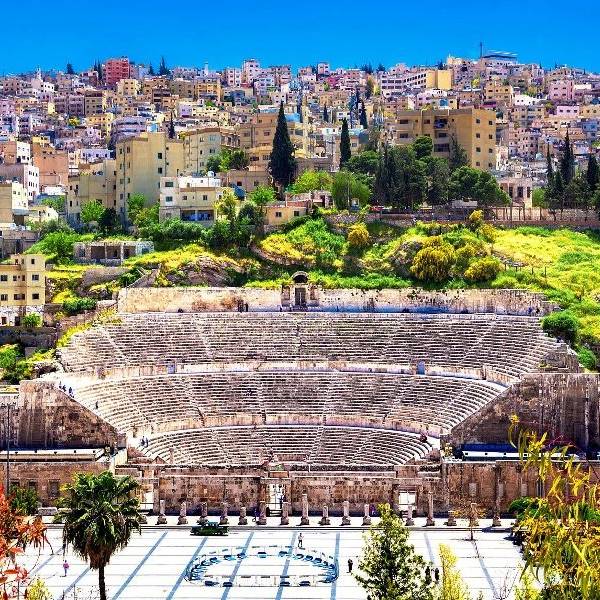
Home < Jordan < King Abdullah I Mosque King Abdullah I Mosque The King Abdullah I Mosque, located in Amman, is a remarkable example of modern Islamic architecture. Named after King Abdullah I, the founder of the modern Hashemite Kingdom of Jordan, the mosque’s design features a central dome and four smaller domes, complemented by a tall minaret. Its spacious prayer hall can accommodate thousands of worshipers and showcases intricate designs, calligraphy, and geometric patterns. The mosque’s significance extends beyond religious worship, serving as a symbol of unity and a popular tourist attraction. With its serene courtyard and well-maintained gardens, the King Abdullah I Mosque stands as a cultural and architectural treasure, honoring Jordan’s history and heritage. Home < Jordan < King Abduallah I Mosque
Home < Jordan < Hijaz Railway Station Hijaz Railway Station The Hijaz Railway, also known as the Hejaz Railway, was a significant railway line constructed in the early 20th century to connect Damascus Syria with Medina Saudi Arabia through various stops in Jordan. The Amman station served as a stopping point for passengers and goods traveling between Damascus and Medina, connecting the region to other parts of the Middle East. The Hijaz Railway was built to facilitate the annual Hajj pilgrimage, allowing Muslim pilgrims from all over the world to reach the holy city of Medina easily. The railway line was a significant engineering feat of its time and represented an important transportation and communication link in the region. Today, while the railway itself is no longer operational in Jordan, some remnants and historical sites related to the railway can still be found in the country, providing insights into its historical significance. Home < Jordan < Hijaz Railway Station

Home < Jordan < Iraq Al Amir Iraq Al Amir Iraq Al Amir is a historic and culturally significant site located in the outskirts of Amman, Jordan. Nestled in the beautiful Wadi Al Seer Valley, this ancient settlement offers a fascinating glimpse into the rich history of the region. With its well-preserved ruins, picturesque landscapes, and historical significance, Iraq Al Amir has become a popular destination for locals and tourists alike. The site’s history can be traced back to the Hellenistic period, and it later flourished during the Nabatean and Roman eras. The ruins consist of a fortified palace complex, including structures such as a castle, watchtowers, water channels, and caves. These architectural remains provide valuable insights into the daily life and architectural achievements of ancient civilizations. One of the notable features of Iraq Al Amir is its famous “Qasr Al-Abd” or “Castle of the Slave.” This imposing structure, built during the 2nd century BCE, showcases intricate carvings, ornamental details, and a unique blend of Hellenistic and Nabatean architectural styles. Exploring the castle and its surroundings allows visitors to imagine the grandeur and historical significance of the site. The natural beauty surrounding Iraq Al Amir is equally captivating. The site is enveloped by lush greenery, olive groves, and scenic views of the Wadi Al Seer Valley. Visitors can take leisurely walks along the hiking trails, enjoying the tranquility of the surroundings while discovering hidden gems and archaeological remnants. Iraq Al Amir stands as a testament to the rich history, architectural brilliance, and natural beauty of the Amman region. Exploring its ruins, admiring its intricate carvings, and immersing oneself in its serene surroundings is a truly enriching experience. The site serves as a gateway to the past, allowing visitors to connect with the ancient civilizations that once thrived in this remarkable corner of Jordan. Home < Jordan < Iraq Al Amir

Home < Jordan < The Roman Theatre The Roman Theatre The Roman Theatre in Amman, Jordan, is an impressive and well-preserved ancient structure that stands as a testament to the rich history and cultural heritage of the region. Situated in the heart of downtown Amman, it serves as a prominent landmark and a popular tourist attraction. Dating back to the 2nd century CE, during the height of the Roman Empire, the theatre was built under the rule of Emperor Antoninus Pius and expanded during the reign of Emperor Commodus. Its construction was a testament to the influence and grandeur of Roman architecture and engineering. The Roman Theatre is carved into a hillside, providing a natural slope for seating, and its design takes advantage of the terrain, allowing for excellent acoustics that still impress visitors to this day. It was originally built to accommodate approximately 6,000 spectators, who gathered to enjoy various forms of entertainment, including theatrical performances, poetry recitals, and musical concerts. The theatre’s façade features a blend of Roman and local architectural styles. The main entrance, adorned with Corinthian columns, leads to a grand stage framed by impressive stone arches. The seating area consists of several tiers divided by walkways, providing access to different sections of the theatre. From the higher tiers, visitors can enjoy breathtaking views of the surrounding cityscape. Over the centuries, the Roman Theatre has undergone periods of neglect and rediscovery. Excavations and restoration efforts, particularly in the 20th century, have brought the theatre back to its former glory. Today, it hosts cultural events and performances, including the annual Amman Citadel Festival, which attracts both locals and tourists alike. Visiting the Roman Theatre offers a unique opportunity to step back in time and immerse oneself in the ancient world. Walking through the well-preserved ruins and imagining the vibrant atmosphere of its heyday can evoke a sense of awe and wonder. The site is also complemented by a nearby museum that showcases artifacts and provides further historical context. The Roman Theatre stands as a symbol of Amman’s enduring history and the cultural exchange that took place in the ancient world. It serves as a tangible link between the past and the present, inviting visitors to explore the fascinating legacy of the Roman Empire and appreciate the architectural and artistic achievements of that era. Home < Jordan < The Roman Theatre

Home < Jordan < The Nymphaeum The Nymphaeum The Roman Nymphaeum in Amman, Jordan, is a captivating archaeological site that offers a glimpse into the opulence and architectural splendor of ancient Rome. Located in the heart of downtown Amman, it stands as a testament to the city’s rich history and the cultural exchange that occurred during the Roman period. The Nymphaeum was constructed during the 2nd century CE, at a time when the Roman Empire was flourishing. It served as a grand public fountain and shrine dedicated to the nymphs, mythical beings associated with water and nature. This type of ornate structure was commonly found in Roman cities, serving as elaborate centers for social gatherings and religious rituals. The Amman Nymphaeum was a marvel of Roman engineering and artistic craftsmanship. It was built with carefully cut local limestone blocks and adorned with intricate carvings, statues, and ornamental details. The facade featured majestic arches and columns, reminiscent of the architectural style prevalent during the Roman era. The Nymphaeum was designed to captivate and impress visitors. Its central feature was a grand pool, fed by an aqueduct system that supplied fresh water. Water cascaded from numerous spouts and decorative outlets, creating a mesmerizing display. The architecture and design of the Nymphaeum were intended to evoke a sense of tranquility and aesthetic pleasure, making it a favored gathering place for the people of Amman. Over the centuries, the Nymphaeum suffered from neglect and natural decay. However, archaeological excavations and restoration efforts have brought the site back to life, showcasing its former grandeur. Today, visitors can explore the partially reconstructed remains, marvel at the architectural details, and gain insight into the significance of water in ancient Roman society. The Nymphaeum is not only a testament to Roman engineering and design but also a window into the social and cultural life of the past. It provides a fascinating glimpse into the daily rituals and communal activities that took place in the ancient city of Amman. The site’s historical and artistic value has made it a popular attraction, drawing both history enthusiasts and casual visitors. Visiting the Roman Nymphaeum allows one to appreciate the fusion of Roman and local architectural styles, while also immersing oneself in the captivating ambiance of an ancient urban sanctuary. The site’s serene atmosphere, combined with its historical significance, creates a memorable experience that offers a deeper understanding of Amman’s rich past and the enduring legacy of the Roman Empire. Home < Jordan < The Nymphaeum

Home < Jordan < The Folklore Museum The Folklore Museum The Folklore Museum of Amman is a captivating cultural destination that offers a unique insight into the traditional heritage and rich folklore of Jordan. Located in the heart of Amman, the museum showcases a diverse collection of artifacts, costumes, and displays that depict the customs, traditions, and everyday life of the Jordanian people. Here is a description of the Folklore Museum of Amman: Preserving Heritage: The museum is dedicated to preserving and celebrating the cultural heritage of Jordan. It serves as a repository of Jordanian folklore, showcasing the customs, traditions, and craftsmanship that have shaped the identity of the local communities throughout history. The museum aims to educate visitors and promote an appreciation for the rich cultural tapestry of the region. Authentic Cultural Experience: The museum provides an immersive experience, allowing visitors to engage with the culture and folklore of Jordan. Traditional music, dance performances, and storytelling sessions are often held within the museum, creating an authentic ambiance that brings the folklore to life. Visitors can witness the vibrant costumes, hear the melodies of traditional music, and witness the captivating dances that are part of Jordan’s heritage. Visiting the Folklore Museum of Amman is a journey into the captivating world of Jordanian folklore. It offers a unique opportunity to explore the customs, traditions, and artistic expressions that have shaped the identity of the Jordanian people. Whether you are a culture enthusiast, a history lover, or simply curious about the local heritage, the Folklore Museum of Amman provides a fascinating and educational experience that celebrates the rich folklore of Jordan. Home < Jordan < The Folklore Museum

Home < Jordan < The Archeological Museum The Archeological Museum The Archaeological Museum of Amman is a captivating destination that takes you on a journey through Jordan’s rich history and ancient civilizations. Located in the heart of Amman, the museum showcases a remarkable collection of artifacts discovered at archaeological sites across the country. Here is a description of the Archaeological Museum of Amman: Treasures of the Past: The museum houses an extensive and diverse collection of artifacts that span several millennia, offering a glimpse into the fascinating history of Jordan. The exhibits include items from the Neolithic period, Bronze Age, Iron Age, Roman, Byzantine, and Islamic periods, among others. These treasures bring to life the stories of the civilizations that once flourished in the region. Ancient Artifacts: The museum’s collection includes a wide range of ancient artifacts, such as statues, sculptures, pottery, jewelry, and everyday objects. These items provide valuable insights into the cultural, religious, and artistic practices of the past. Visitors can marvel at intricately carved reliefs, admire delicate jewelry craftsmanship, and appreciate the skill of ancient artisans. Archaeological Discoveries: The Archaeological Museum of Amman serves as a platform to showcase the ongoing archaeological excavations in Jordan. It highlights recent discoveries and research, shedding light on the continuous exploration and uncovering of new insights into the region’s past. This dynamic aspect of the museum keeps the exhibits fresh and encourages a deeper appreciation for the field of archaeology. Visiting the museum offers a captivating journey through time, allowing visitors to appreciate the rich cultural heritage of Jordan. Whether you are a history enthusiast, an art lover, or simply curious about the past, the Archaeological Museum of Amman provides an immersive and educational experience that showcases the remarkable legacy of ancient civilizations in the region. Home < Jordan < The Archeological Museum

Home < Jordan < Rainbow Street Rainbow Street Rainbow Street is a vibrant and iconic street located in the old part Amman. Known for its lively atmosphere and diverse offerings, Rainbow Street has become a popular destination for locals and tourists alike. Here is a description of Rainbow Street: Character and Charm: Rainbow Street is a bustling and colorful street that exudes a unique charm. Its name is derived from the vibrant mix of buildings painted in different hues, creating a visual spectacle that adds to its allure. The street is lined with a mix of historic and modern buildings, giving it a distinctive character. Cafes and Restaurants: Rainbow Street is renowned for its eclectic culinary scene. The street is filled with numerous cafes, restaurants, and eateries that offer a wide range of cuisines, from traditional Jordanian dishes to international flavors. It’s a perfect place to indulge in local delicacies, sip a cup of Arabic coffee, or savor a delicious meal while immersing yourself in the energetic ambiance. Shopping and Boutiques: Along Rainbow Street, you’ll find a variety of boutique shops and stores selling unique and locally crafted items. From handmade crafts, jewelry, and traditional clothing to contemporary art and souvenirs, the street offers a diverse shopping experience. Exploring the shops on Rainbow Street provides an opportunity to discover authentic Jordanian products and take home memorable keepsakes. Art and Culture: Rainbow Street is also a hub of art and culture in Amman. It is home to numerous art galleries, showcasing works by local and international artists. The street often hosts cultural events, exhibitions, and performances, providing a platform for artists to showcase their talent and for visitors to immerse themselves in the artistic scene of Amman. Historic Landmarks: Rainbow Street is in close proximity to several historic landmarks, adding to its appeal. It is within walking distance of the Roman Theater, the Amman Citadel, and other ancient sites. Exploring Rainbow Street allows visitors to seamlessly combine cultural exploration with leisurely strolls, as they witness the blending of old and new within the city. Overall, Rainbow Street offers a vibrant and lively experience, combining a mix of culinary delights, shopping opportunities, artistic expressions, and historic charm. It is a must-visit destination in Amman, providing an authentic and dynamic atmosphere that captivates visitors from all walks of life. Home < Jordan < Rainbow Street Journey through the Middle East, with us by your side. Important Links Home About Us Services FAQ Blog Contact Featured Desitnations Jordan The Holy Land Egypt United Arab Emirates Morocco Oman Contact us 351 University St. – 3rd Floor – Suite 4 PO box 1992 Amman, 11941 Jordan Phone : +962 6 537 1616 Email: contact@axisdmc.com Copyright © 2023 AXIS DMC All Rights Reserved Terms and Conditions Privacy Policy Facebook-f Twitter Linkedin-in Youtube Instagram

Home < Jordan < Amman Citadel Amman Citadel The Amman Citadel, also known as Jabal al-Qal’a, is an archaeological site located in the heart of Amman, the capital city of Jordan. Perched on the top of a hill, it offers a panoramic view of the modern city and its surroundings. The citadel has a rich history that spans several millennia, with evidence of human occupation dating back to the Neolithic period. Key Features and Historical Significance: Ruins and Structures: The Amman Citadel is home to numerous ruins and structures from different historical periods. The most prominent is the Umayyad Palace, which dates back to the 8th century. Other notable structures include the Temple of Hercules, a Byzantine church, and remnants of a Roman theater. Temple of Hercules: One of the most iconic features of the citadel is the Temple of Hercules. It is believed to have been built during the Roman period and is dedicated to the Roman god Hercules. The temple’s towering columns are an impressive sight and provide insight into the architectural grandeur of the time. Archaeological Museum: The citadel also houses an archaeological museum that displays a wide range of artifacts discovered during excavations at the site. The museum showcases artifacts from various periods, including the Bronze Age, Iron Age, and Roman, Byzantine, and Islamic periods. History and Occupations: The Amman Citadel has witnessed the rise and fall of numerous civilizations. It was occupied by the Ammonites, Assyrians, Babylonians, Persians, Greeks, Romans, Byzantines, and Umayyads, among others. The diverse layers of history at the site offer valuable insights into the region’s ancient civilizations. Ongoing Excavations: The site continues to be an active archaeological excavation site, uncovering new discoveries and shedding light on the historical significance of the area. Ongoing research and excavations contribute to a deeper understanding of Amman’s past and the civilizations that once thrived there. Visiting the Amman Citadel: The Amman Citadel is a popular tourist destination and offers a unique opportunity to explore Jordan’s rich history. Visitors can walk through the ruins, climb the ancient steps, and enjoy the breathtaking views of the city below. The site is well-preserved, and information panels are placed at key locations to provide historical context. The Archaeological Museum provides further insight into the artifacts and history of the region. In conclusion, the Amman Citadel is a fascinating archaeological site that showcases the layered history of Jordan’s capital city. With its impressive ruins, panoramic views, and ongoing excavations, it is a must-visit destination for history enthusiasts and travelers alike. Home < Jordan < Amman Citadel









